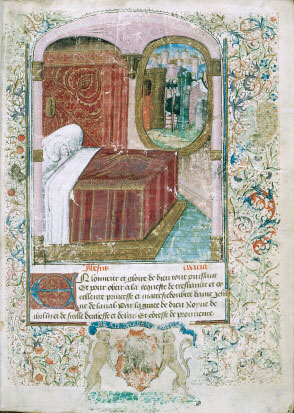
The Canterbury Tales is a collection of 24 stories that runs to over 17,000 lines written in Middle English by Geoffrey Chaucer between 1387 and 1400. In 1386, Chaucer became Controller of Customs and Justice of Peace and, in 1389, Clerk of the King's work. It was during these years that Chaucer began working on his most famous text, The Canterbury Tales. The tales are presented as part of a story-telling contest by a group of pilgrims as they travel together from London to Canterbury to visit the shrine of Saint Thomas Becket at Canterbury Cathedral. The prize for this contest is a free meal at the Tabard Inn at Southwark on their return.
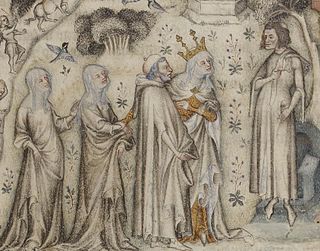
Guillaume de Machaut was a medieval French poet and composer. He is regarded by many musicologists as the greatest and most important composer of the 14th century. Machaut is one of the earliest composers on whom substantial biographical information is available, and Daniel Leech-Wilkinson called him "the last great poet who was also a composer". Well into the 15th century, Machaut's poetry was greatly admired and imitated by other poets, including Geoffrey Chaucer.

Le Roman de la Rose is a medieval French poem styled as an allegorical dream vision. It is a notable instance of courtly literature. The work's stated purpose is both to entertain and to teach others about the art of romantic love. Throughout the poem, Rose is used both as the name of the titular lady and as a symbol of female sexuality. The other characters' names also function both as regular names and as abstractions illustrating the various factors that are involved in a love affair.
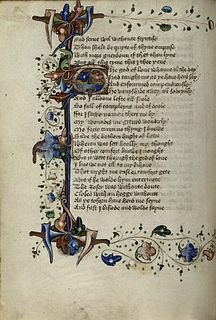
The Romaunt of the Rose is a partial translation into Middle English of the French allegorical poem, le Roman de la Rose. Originally believed to be the work of Chaucer, the Romaunt inspired controversy among 19th-century scholars when parts of the text were found to differ in style from Chaucer's other works. Also the text was found to contain three distinct fragments of translation. Together, the fragments—A, B, and C--provide a translation of approximately one-third of Le Roman.
Juan Ruiz, known as the Archpriest of Hita, was a medieval Castilian poet. He is best known for his ribald, earthy poem, Libro de buen amor.
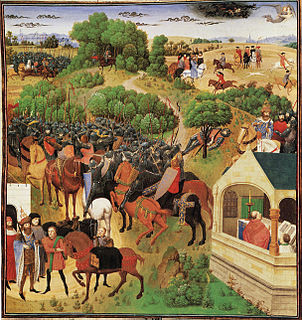
The chanson de geste is a medieval narrative, a type of epic poem that appears at the dawn of French literature. The earliest known poems of this genre date from the late eleventh and early twelfth centuries, before the emergence of the lyric poetry of the trouvères (troubadours) and the earliest verse romances. They reached their apogee in the period 1150–1250.
Années de pèlerinage is a set of three suites for solo piano by Franz Liszt. Much of it derives from his earlier work, Album d'un voyageur, his first major published piano cycle, which was composed between 1835 and 1838 and published in 1842. Années de pèlerinage is widely considered as the masterwork and summation of Liszt's musical style. The third volume is notable as an example of his later style. Composed well after the first two volumes, it displays less virtuosity and more harmonic experimentation.
Jean de Meun was a French author best known for his continuation of the Roman de la Rose.
Le Pèlerinage de Charlemagne or Voyage de Charlemagne à Jérusalem et à Constantinople is an Old French chanson de geste dealing with a fictional expedition by Charlemagne and his knights. The oldest known written version was probably composed around 1140. Two 15th-century reworkings of the story are also known.
Edmond Faral was an Algerian-born French medievalist. He became in 1924 Professor of Latin literature at the Collège de France.
Guillaume de Dole is an Old French narrative romance by Jean Renart. Composed in the early 13th century, the poem is 5,656 lines long and is especially notable for the large number of chansons it contains, and for its active female protagonist. The romance incorporates forty-six chansons ; it is the first extant example in French literature of a text that combines narrative and lyric. Its form was quickly imitated, by authors such as Gerbert de Montreuil, and by the end of the 13th century had become canonical.
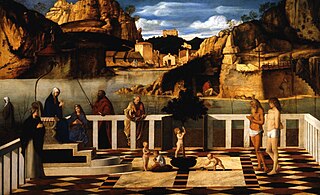
The Holy Allegory is a painting by the Italian Renaissance master Giovanni Bellini, dating from c. 1490 to 1500. It is in the Uffizi gallery in Florence, Italy.
Siege of Thebes is a 4716 line poem written by John Lydgate between 1420 and 1422. Lydgate composed the Siege of Thebes directly following his composition of Troy Book - which was patronized by King Henry V - and directly preceding his production of Fall of Princes - which Humphrey Duke of Gloucester patronized during King Henry VI's regency. The poem is particularly significant because it was written without an identifiable patron, and most probably without patron or commission whatsoever. But, whatever the status of its patronage, the Siege of Thebes still managed to gain significant popularity, attested to by its 31 surviving manuscripts. The poem is, in large part, a response to Geoffrey Chaucer's The Canterbury Tales. Lydgate's poem borrows The Canterbury Tales pilgrimage-based framing device and is written as an additional tale in the cycle. However, unlike Chaucer, Lydgate establishes himself as the narrator of the work, and recounts the Siege of Thebes. Lydgate's Siege of Thebes follows and expands upon the Theban Cycle, but makes significant additions to the source materials.
The Floure and the Leafe is an anonymous Middle English allegorical poem in 595 lines of rhyme royal, written around 1470. During the 17th, 18th, and most of the 19th century it was mistakenly believed to be the work of Geoffrey Chaucer, and was generally considered to be one of his finest poems. The name of the author is not known but the poem presents itself as the work of a woman, and some critics are inclined to take this at face value. The poet was certainly well-read, there being a number of echoes of earlier writers in the poem, including Geoffrey Chaucer, John Lydgate, John Gower, Andreas Capellanus, Guillaume de Lorris, Guillaume de Machaut, Jean Froissart, Eustache Deschamps, Christine de Pizan, and the authors of the "Lai du Trot" and the Kingis Quair.

The Spiritual Canticle, is one of the poetic works of the Spanish mystical poet St. John of the Cross.
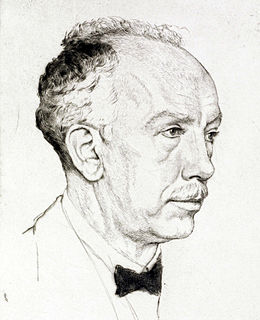
Sechs Lieder, Op. 68, is a collection of six Lieder by Richard Strauss. He composed them, setting poems by Clemens Brentano, in 1918 for soprano and piano, and orchestrated one in 1933 and five in 1940. The piano version was first published by Adolph Fürstner in Berlin in 1919. They are also known as Brentano Lieder.
